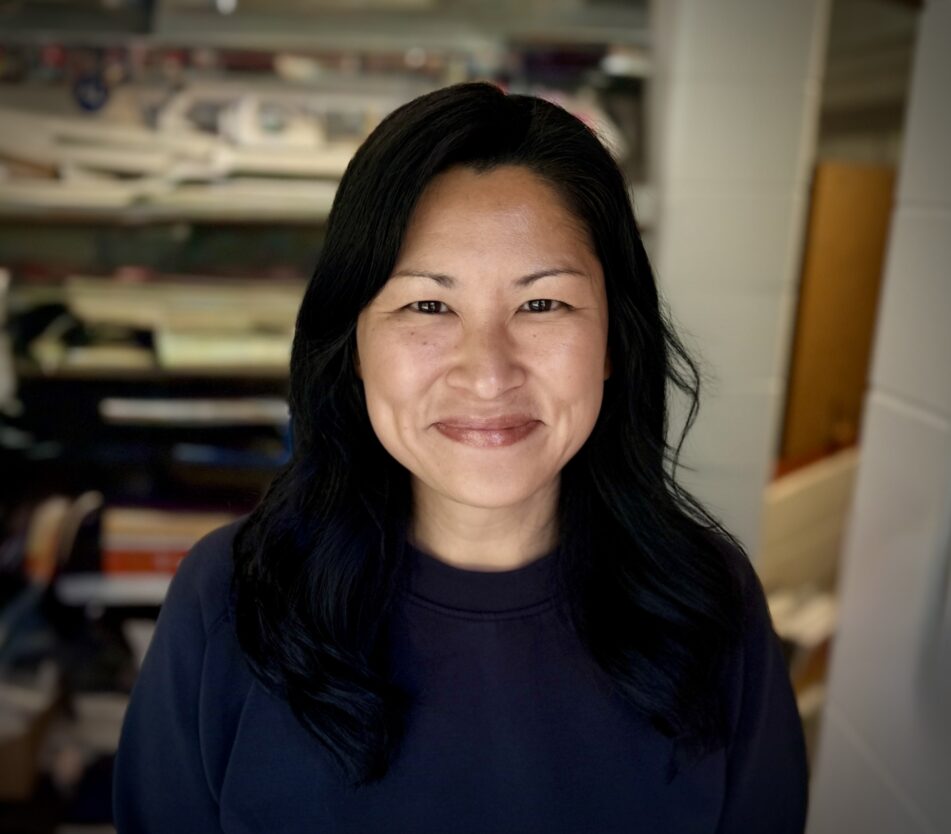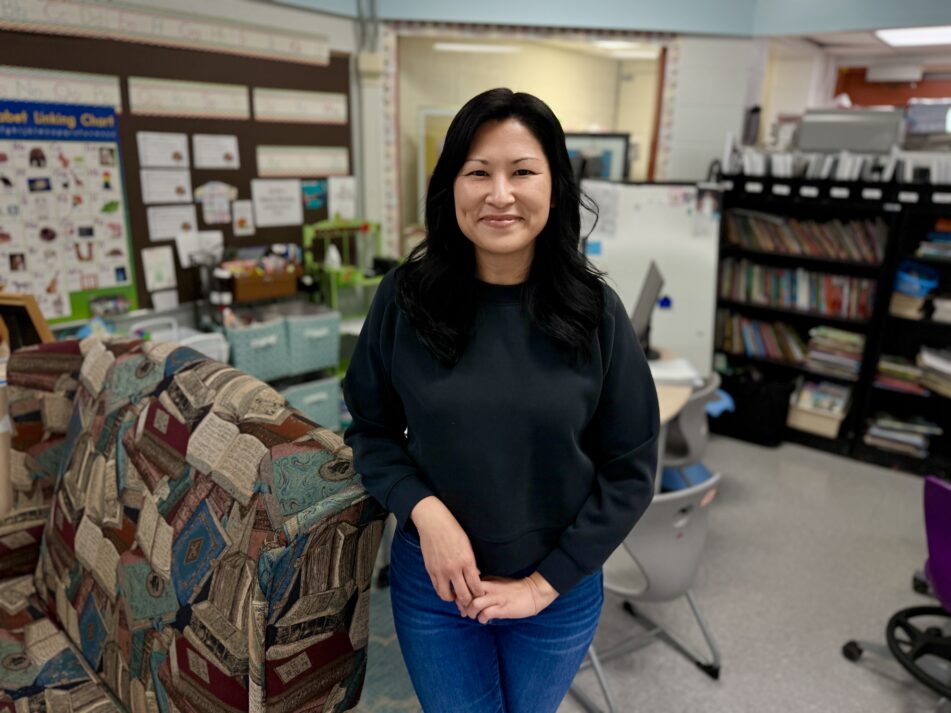

Suzanne Vu was born in Orange County, California, and grew up in San Diego. She attended the University of California, Santa Barbara as an undergrad, spent a gap year traveling, and then attended graduate school at the University of Michigan. She lives in Chelsea with her husband, two children, and a spirited Belgian Malinois. She enjoys crafting, scrapbooking, spending time with family and friends, traveling, trying new things, DIY projects, and spontaneous adventures.
Logan Principal Will Wright calls Vu an outstanding educator who brings expertise and collaboration to her work every day.
“Her deep knowledge of English Language instruction allows her to thoughtfully tailor support to meet each student’s unique needs,” he says. “Suzanne builds strong, trusting relationships with families and is actively involved in every part of our school community. Her dedication makes a lasting difference for our multilingual learners and for Logan as a whole.”
What initially drew you to teaching English Learners, and how long have you been working in this field?
I was drawn to working with English Learners because I was one myself! I grew up in a multilingual, multicultural family to Deaf immigrant parents who fled to the United States in the late 1970s.
Upon graduating, I subbed and completed a long-term assignment before being hired as an English Learner teacher in Macomb County. This is the start of my 18th year in education.
What are the most effective strategies you’ve found for helping students who are just beginning to learn English feel comfortable and confident in your classroom?
Making connections with students is vital to creating a comforting and safe place, especially for ELs. I like to meet families and students prior to their first day of school so they have a familiar face at Logan. It’s important to me to connect with students daily, whether it’s a greeting, check in or follow-up with something they’ve shared.
Another effective strategy is to respect the silent period, as everyone has their own timeline when adjusting to an unfamiliar place; thus, getting to know a student is imperative to increasing their comfort level and confidence.
Can you describe a specific breakthrough moment with a student that reminded you why you love this work?
This is a tough question as I’ve had many breakthrough moments and reminders of why I love working with English Learners. If I had to choose one, it would be a family that relocated to the U.S. from their war-stricken home. They experienced intense culture shock so we worked together to provide resources, helped them navigate social and cultural norms, and supported them as they transitioned into their new life.
The children had a particularly difficult time adjusting. They initially were hesitant to leave their parents and often eloped. We focused on building positive, trusting relationships. I made home visits, took the time to learn about their culture, and held regular meetings with an interpreter to ensure clear communication and mutual understanding. With our partnership, the children began to thrive.
Their effort and growth through their elementary years were truly inspiring. I still keep in contact with the family. It’s always a joy to hear from former students and see how far they’ve come.
What role do families and cultural backgrounds play in your teaching approach, and how do you incorporate students’ home languages and cultures into learning?
This is crucial on so many levels! As aforementioned, families and their cultural backgrounds are at the forefront of my teaching. Having a strong school-family partnership can drastically change the whole child.
I regularly incorporate home languages and student cultures by integrating background knowledge and making connections. Doing this is very beneficial to making learning fun and making it stick! ELs come to us with many asset-based strengths, so I like to tap into them as they work on building their English academic and linguistic proficiency. Typically, students acquire their receptive skills before their expressive skills, so while they may comprehend the lessons or assignments, they might not yet be able to express it in English. To build this, I have them use their native language, or L1, to demonstrate understanding and mastery. This can be in the form of translating directions, providing keywords and phrases verbally and/or in writing, simplifying information, bilingual dictionaries, bilingual volunteers, or attempting to speak their L1. I love when I think I have mastered a word or phrase with the correct intonation in another student’s language, and they laugh graciously!
How do you differentiate instruction to meet the varying English proficiency levels within a single classroom?
When lesson planning, I look at multiple points of data to better understand a student’s profile and what they need! I review their academic and linguistic strengths and weaknesses in English and L1, as well as their expected grade level outcomes, to integrate SIOP strategies to meet our target objectives. Doing this allows me to integrate accommodations to ensure meaningful access to all. I also utilize the WIDA Can Do Descriptors to support students in reaching proficiency close to their native English-speaking peers in the four domains of listening, speaking, reading, and writing.
Providing students the ability to practice the four domains gives them the opportunity to use their strengths in one of the domains to gain comprehensible input. In my class, you may see a lesson that includes strategically paired students to provide speaking opportunities, sentence starters, essay frames, visuals, simplified language in English and their home language, graphic organizers, and the “I do, we do, you do” model.
What are some common misconceptions people have about English Learners that you’d like to address?
Some common misconceptions are that when ELs go through a silent period, they cannot comprehend or complete tasks. On the other hand, students who have acquired their basic interpersonal communicative skills (BICS), or social language, can comprehend everything expected for their grade level. They may have conversational skills, but need additional support in building their cognitive academic language proficiency (CALP) to access grade-level curriculum. This can take students up to 5-7 years, depending on their native language development.
How do you collaborate with other teachers to support your students’ academic success across all subjects?
I collaborate with my colleagues by having regular communication about our students. This may be in the form of emails, quick check-ins, data team meetings, and sharing the progress monitoring communication log. Regular communication is essential to providing ongoing support for our students!
What resources or tools have been game-changers in your English Learner instruction?
Technology has come a long way! It’s great to have translation tools at my fingertips to instantaneously provide clarification or simplify directions. I am also impressed with app-based programs such as Talking Points, which allow me to communicate with families whose native language is not English. I can send a message in English, and the family can reply using their preferred language. I also learned of earbuds that provide live translations! This will be an interesting tool when it becomes more accessible.
Outside of teaching, what hobbies or interests do you have, and have any of them unexpectedly helped you connect with your students or enhance your teaching?
Traveling to different countries has given me a glimpse of what some of my students’ lives were like before coming to the United States. Being able to talk about their cultural values and familiar places from home has helped me make stronger connections. Families have also made me delicious home meals, which fuel my continued passion for trying new foods!
What would surprise coworkers to know about you?
Hmm…it might surprise some that I actually enjoy hiking and being outdoors. I didn’t grow up camping so when my husband took me tent camping for the first and only time, let’s just say it wasn’t exactly a smooth experience! It was enough to know it wasn’t my idea of fun, but after we had our first child and bought a motorhome, I was all in! We traveled all over the U.S. and went cross-country three times.

What do you like about working at AAPS, and at Logan in particular?
I love that AAPS brings in families from all walks of life whom I have had the pleasure of meeting or working with; some have even bloomed into personal friendships! It’s fun to run into former and current students in town. They are always caught off guard when they see their teachers outside of school. We’re like local celebrities!
Logan holds a special place in my heart as a staff member and parent. The community is caring and looks out for each other. The staff puts students first, no matter how difficult it can be. Everyone lends a hand and pulls together to make things happen.
How do you spend your summers?
I typically do a deep cleaning when the school year ends before I officially declare summer break. We visit family and friends in Southern California, go on several family vacations, head up north because you’re not from Michigan if you don’t go at least once, and put on my taxi hat to transport my children around to their camps and activities. If there is time, I’ll squeeze in a home DIY project!

Be the first to comment